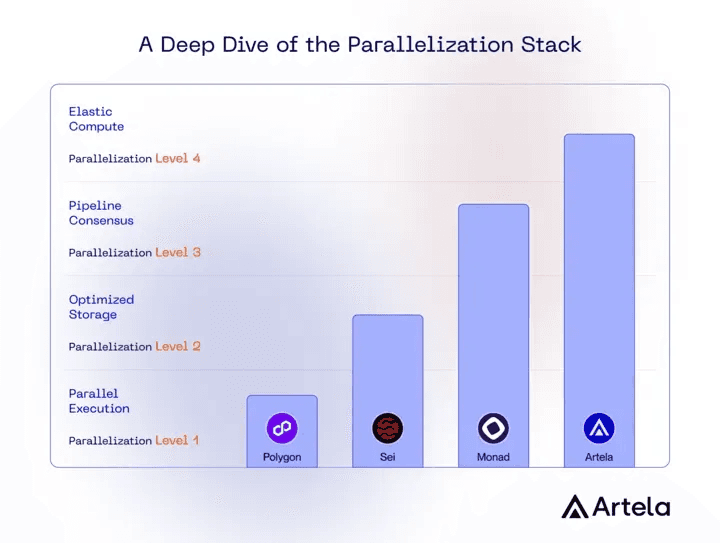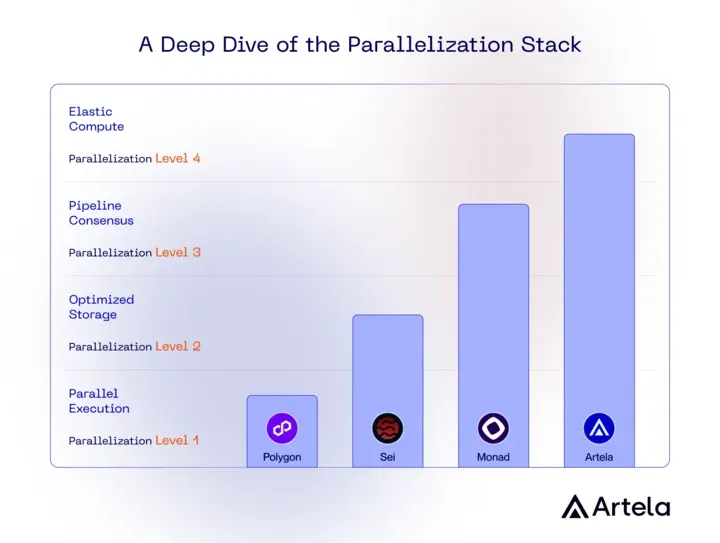The Race for Parallel EVM: Future Innovation Prospects
Oct 11, 2024
Featured
How much do you know about “Parallel EVM”? What changes do different blockchain components need to undergo to enable parallel execution of transactions? If we categorize the levels of parallelization, what would they look like? And how do new directions like PayFi need to integrate this new engine?
This blog explores the deeper concepts behind Parallel EVM, the extreme innovations driving it, and how technology and scenarios continue to evolve.
Understanding Parallel EVM in a Non-technical Way
When the EVM processes a block, the transactions within the block are lined up in a single line and processed one by one. In contrast, Parallel EVM arranges the transactions into multiple lines, allowing them to be processed simultaneously, which significantly speeds up block processing.
Breaking a single line into multiple lines might seem straightforward, but it’s far from easy. Imagine running a fast-food restaurant: opening more order windows can create multiple lines, but can the kitchen keep up with the order flow? Even if you add more chefs, you still face limitations with space and equipment.
Eventually, you’ll find that higher throughput in a fast-food chain often requires the integration of high-tech automation. What appears to be a simple solution – adding more order windows – only works with millions of dollars of investment in automated kitchen equipment.
Parallelization Levels of EVM
Like running a restaurant, parallel EVM seems simple on the surface, but it requires collaboration across all blockchain components to achieve high performance. Parallelizing the EVM isn’t about solving one isolated problem – it’s about tackling a series of interconnected technical challenges that demand optimization from surface-level features down to the core.
Let’s break down the “parallelization levels of EVM” and explore how different projects approach these optimizations.

Level 1 — Parallelizing Execution
The simplest form of parallel EVM is grouping transactions so they can be processed simultaneously, while still producing results consistent with serial execution. This feature improves block execution speed.
Projects like Polygon PoS and BNB Chain have pioneered efforts to introduce parallel execution to enhance performance. However, as live runtime blockchains, they face limitations in fully optimizing all components, achieving only this level of parallelization.
Level 2 — Optimizing Storage
Once transactions are processed, the EVM needs to update data storage. Without improved data updating efficiency, storage becomes the new bottleneck. This optimization level enhances not just execution speed, but also the efficiency of storage data updates.
New L1 chains like Sei, Monad, and Artela, free from legacy constraints, designed specifically around parallelization, have focused on optimizing storage from the ground up. Solutions like Sei DB, Monad DB, and Artela’s Parallel Storage are key to achieving high-performance storage.
Level 3 — Pipelining Consensus
With execution and storage no longer bottlenecks, we can then speed up block packaging and increase transaction throughput by improving consensus algorithms. At this level, it can further improve the overall transaction throughput.
Monad, for example, introduces “deferred-execution”, separating execution from the consensus process. This allows consensus to focus on block data, instead of execution, thus resulting in higher throughput. Artela's Elastic Block Space allows the block size to elastically adjust during the consensus process.
Level 4 — Elastic Computing
Once consensus, execution, and storage are all parallelized, blockchains enter the next stage: elastic computing, much like cloud services.
Artela, built on full-stack parallelization, has introduced Elastic Block Space, functioning like cloud computing. Network dynamically scales processing power based on dApp needs, offering a high level of parallelization. With dedicated Elastic Block Space, dApps enjoy predictable performance, ensuring stability for large-scale consumer use.
Artela’s diagram helps illustrate the four levels of parallelization. It mirrors the evolution of high-performance servers, from single-server setups to read-write separation, and finally to elastic scaling of both read and write operations.

What Comes Next After Parallel EVM?
As we’ve seen, Parallel EVM is just the surface. The deeper we optimize, the more it becomes clear that blockchain performance is about more than just the EVM – it’s about improving all non-EVM components as well. The ultimate goal is extreme innovation around blockchain performance along with EVM compatibility.
Does this performance optimization of Parallel EVM ever stop? To answer that, we can draw insights from the evolution of Web2 server technologies.
As large-scale applications continued to grow, the development of Web2 server technologies progressed through several stages:
Single-server architecture: Early servers depended on single physical devices, limiting scalability and performance.
Scale-up: By upgrading hardware (e.g., more powerful CPUs and larger memory), single-server performance improved, but still faced clear limitations.
Scale-out: In the cloud era, adding more servers and forming clusters enabled horizontal scaling, overcoming the constraints of single-server setups.
Heterogeneous computing: With the rise of AI and deep learning, the integration of GPUs, TPUs, and other specialized computing resources boosted performance for tasks requiring high computational power.
By placing the latest high-performance blockchain performance stacks into one diagram, we can envision the evolution of a forward-looking technical architecture.

New blockchains without legacy constraints, like Sei and Monad, are pushing the boundaries of scale-up through parallel EVM.
Artela, on the other hand, goes further by combining parallelization with scale-out, enabling predictable performance.
In addition to Parallel EVM, the Dual VMs approach is being adopted, with Arbitrum and Artela incorporating WASM as a form of heterogeneous computing into their blockchain architecture, further addressing EVM’s limitations.
Why Enhancing Parallel EVM Matters
Back to the restaurant example, not every restaurant needs a high-tech kitchen, but modern fast-food chains do to compete in the mass market. Similarly, classic DeFi protocols might not require parallel EVM, but as the crypto industry shifts towards value realization, new protocols now have the foundation for exploration.
PayFi, an innovative combination of crypto assets, stablecoins, payments, and DeFi, promises to unleash the potential of blockchain payment systems, creating a more liquid and adaptive global financial market. Fast settlement, low fees, and a robust developer ecosystem are essential for PayFi’s success. Compared to non-EVM high-performance chains, Parallel EVM offers a unique advantage: compatibility with the existing EVM ecosystem, which boasts the strongest TVL, developer base, and mature stack. Parallel EVM builds on this, providing fast settlement and low transaction fees, making it the ideal environment for incubating PayFi.
Reforge Research’s article, “Death, Taxes, and EVM Parallelization”, summarizes insights from major players in the parallel EVM space. New directions in DeFi are becoming possible, such as Programmable Central Limit Order Books (pCLOB). By leveraging performance and parallelization provided by Parallel EVM, pCLOBs can offer complex and efficient trading functions in a decentralized setting. These functions enable the embedding of custom logic during order submission and execution, allowing for additional validation, condition checks, and dynamic fee adjustments. This flexibility enhances security and supports more advanced trading strategies and financial products.
At the 2024 Token2049 event in Singapore, the consumer narrative gained momentum with several projects aiming to bring Web3 into everyday life. Morph introduced a consumer-grade Layer 2, branding itself as "A Global Consumer Layer" to break the "ghost town" blockchain curse and inflated TVL. Projects like Matr1x Fire and Shrapnel, hardcore FPS games, are delivering amazing gameplay comparable to traditional titles. These projects are pushing crypto further into the mainstream by addressing the gap that DeFi, NFTs, and earlier dApps have not filled. Their potential mass adoption places higher demands on infrastructure. Parallel EVM could be the key foundation.
If these new directions succeed, the parallelization of EVM will, much like cloud computing infrastructure, become a long-term endeavor of continuous optimization and innovation.
Summary
Parallel EVM is merely a generalization of high-performance EVM. On the surface, it refers to the parallel execution of EVM transactions, but in reality, it’s a case of "a single action affecting the whole system"—it requires deep optimization of all technical components. We use different levels of parallelization to categorize the degrees of implementation. As the infrastructure continues to unlock consumer use cases, the advantages of parallel EVM are expected to elevate the ecosystem's past achievements to new heights.

